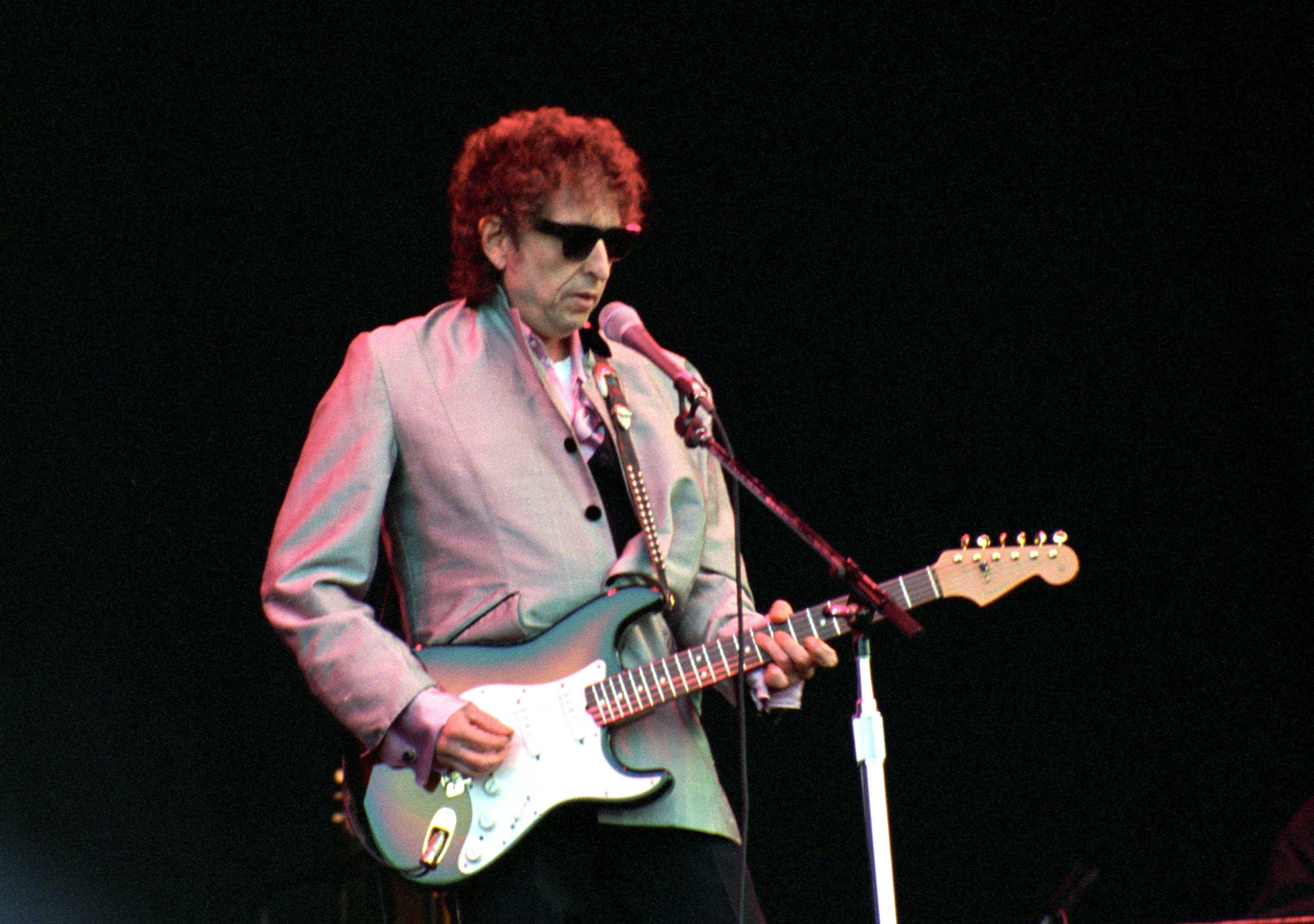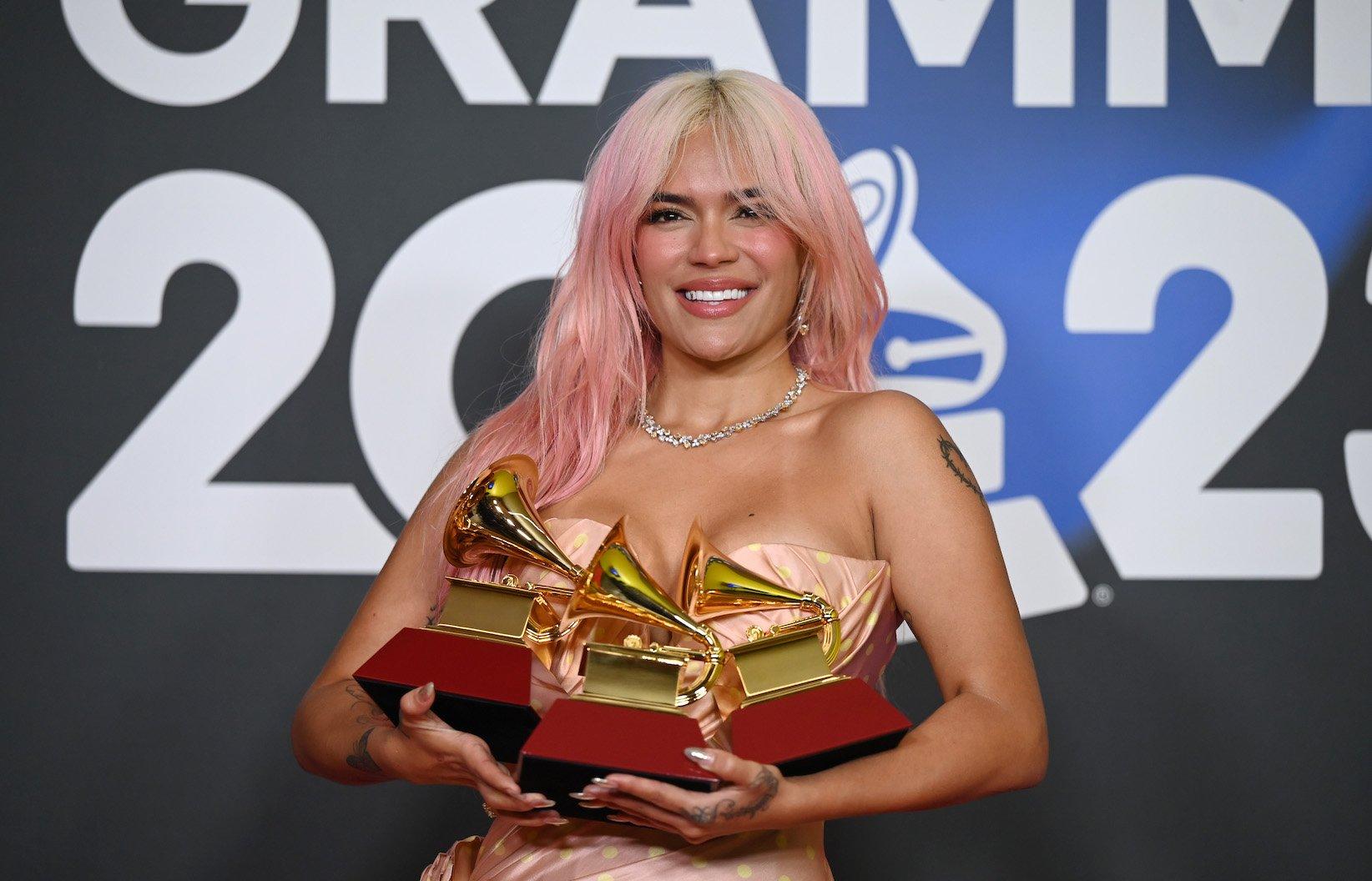Photo: Keith Baugh/Getty Images

Bob Dylan
news
Revisiting Bob Dylan's "Time Out Of Mind" 20 Years Later
How the Album Of The Year GRAMMY winner came together (and almost didn't come out) and its path to modern classic status
How meaningful must an album be to resurrect and redefine a career as big as Bob Dylan's? How well-crafted must it be to best Paul McCartney, Babyface and Radiohead for the Album Of The Year GRAMMY, spawn hits for Garth Brooks and Adele in the decade to come, and set the sonic bar for modern classics? Time Out Of Mind accomplished all of this.
From early in his career, the mere concept of a new Dylan album had become akin to the old paradoxical riddle: Could God create a stone so heavy that he cannot lift it?
Yet Dylan painted a masterpiece with Time Out Of Mind, an astonishing feat considering how much darkness found its way into this shining moment in his career, how much magic came out in moments of chaotic mishap and given the fact that the album almost didn't come out at all.
"The first time I heard Time Out Of Mind it annoyed me that somebody as exalted as Bob Dylan should parade his misery so blatantly," admits singer/songwriter Robyn Hitchcock, a devout Dylan disciple "Was his life really that wretched, after all he'd achieved, and all the adulation that had come his way?"
By 1997, Dylan hadn't released an album of new original songs in seven years, an unprecedented span for such a prolific artist. His career had already weathered several commercial and critical lulls and resurgences, all the while the man himself continued his "Never Ending Tour," perpetually placing him in front of audiences that so revered him, yet became increasingly fickle as Dylan's perceived heyday distanced.
"Dylan has a way of making his misery connect with your misery, no matter how remote his life may be from most people's," says Hitchcock. "After hearing the record a couple of times, it began to manifest as his latest meditation on loss. To me, loss has always been Dylan's motor: from 'Girl From The North Country' to 'Visions Of Johanna' to 'You're A Big Girl Now' to 'Ring Them Bells' —the terrible acknowledgement that all we love must drain away from us like sand in an hour glass."
At that time, his last successful stint in the studio was for 1989's Oh Mercy, a comeback in its own right. Produced by Daniel Lanois (U2, Peter Gabriel, Robbie Robertson) and engineered by Mark Howard (Tom Waits, Johnny Cash, Neil Young), Oh Mercy had a "two guys on a back porch … kind of vibe," as Lanois described it in a 2011 interview.
That team had worked well together, and in August 1996 Dylan returned to Lanois and Howard to mix a live recording from the House of Blues in Atlanta. Dylan came by to oversee the final mixes at a studio installation they'd built in Oxnard, Calif., called Teatro. There Dylan began to share song ideas with Lanois and shape new sounds at the mixing board next to Howard.
The Album's Gritty Beginnings
As is the case many times in the studio, a small experiment led to the happy accident that provided one of the most important ingredients to the sonic stew of Time Out Of Mind: Dylan's gritty vocal tone.
"I finished this House of Blues recording and I was on the last mix of that when Bob said, 'I play harmonica on this next track. … Is there any way you can make it sound electric?'" recalls Howard. "I said, 'Yes.' So I pumped it through a little [Ibanez] Tube Screamer distortion pedal and then, bam, ran it through a little amp and when the harmonica came on it sounded amazing. Like this old, dirty, Little Walter kind of blues sound."
"Then right after the harmonica stuff," Howard says, "his voice came through the mic and then he heard his voice come through with this distortion all over it. He said, 'I love it.'"
That heavily distorted vocal tone became the signature sound of Time Out Of Mind, and it matched the material perfectly.
"So we were ready to start and then Bob said, 'You know, I can't work this close to home, with the family here. I get distracted,'" says Howard. "'Want to go somewhere else? Let's go to Miami.' Miami was the furthest point away."
<iframe width="620" height="349" src="https://www.youtube.com/embed/9hO-83CIVKM" frameborder="0" allowfullscreen></iframe>
Miami's legendary Criteria Studios was promptly booked, the site that housed such landmark recordings as Derek & The Dominos' "Layla," Bob Marley's "Could You Be Loved," the Eagles' "Hotel California," and even the Bee Gees, "Stayin' Alive."
The stage was set to cut a classic, but something was not right.
"I packed up a truck and I brought all the preamps and little neat side consoles and all the gear I was using," Howard says. "Unfortunately, Criteria, it didn't sound good in there, where at the Teatro I was getting this amazing sound. … So I got spooked at the time. I said, 'Bob, it just doesn't sound good here.'
"So I called the Bee Gees and see if they would let us use their studio and they came back with, 'No.'"
Criteria was ultimately bought two years after the making of Time Out Of Mind, revamped and reopened as the Hit Factory Criteria Miami. But Howard had to think and act quickly.
"I ended up building a studio like a little apartment in there, for Bob where … he could retreat to write lyrics and that was in the main room," Howard continued. "He refused to wear headphones, so he just heard his voice coming out of that little amp while recording … and then the band in the room. So that's how it was tracked."
"Love Sick"
"Every day, 4 o'clock. There was like 15 people pulling in the room all at once," says Howard. Many great players contributed, from drummers Jim Keltner and Brian Blade to multi-instrumentalists Augie Meyers and Jim Dickinson, plus the other road-tested musicians in Dylan's band.
But this many creative forces in one room can create challenges. The engineer's seat behind the console often provides a pragmatic vantage point to reign it all in, but that view can also accentuate the chaos, the way racecars blur by from a fixed front-row seat in the grandstand.
"It was kind of scary because Bob writes on typewriter," Howard recalls. "So on every take he would change the key. So for a musician to change the key, right into the next take, sometimes it's like relearning the whole song. People would be strumming and missing chords and it was quite messy."
According to Howard, some of the takes got pretty far out, but once the musicians gelled, it was up to him to work quickly to get a mix together.
"On a song like 'Love Sick' I put a little flange on Bob's voice with the delay and with the distortion amp so his voice came back and it sounded amazing in the control room, in the playback. So I would print my mix every time I would play it back, because I play it back for the band it's kind of a performance I'm doing for the band, and I'm making moves and doing all the solo rises and stuff like that. … And that song, 'Love Sick', that's the mix that's on the record from that playback. It was one or two of those tracks that I could never better. They just went on the record like that. They were mixed on the spot."
<iframe width="620" height="349" src="https://www.youtube.com/embed/Abbu5hcH0kk" frameborder="0" allowfullscreen></iframe>
"Not Dark Yet"
"I don't even remember what I came here to get away from," Dylan sings in the album's dark, truthful centerpiece, "Not Dark Yet," a song that grieves, ponders and moans, transmitting its confessions across the most fundamental frequencies of the heart.
Hitchcock performed his own haunting version in 2005 at a Dylan-themed event with Led Zeppelin's John Paul Jones Joining him on mandolin.
"'Not Dark Yet' was the song that drew me into the record as I sat in my hotel room in Seattle at dusk in August 1997 and watched 50 TV networks announce that Princess Diana had died," says Hitchcock. "It pinpoints on the map where you are between what you have already lost and what you still have to lose; set in an airless, transient desert town where you keep finding yourself but where nobody belongs."
Indeed, the painful gravity of "Not Dark Yet" is both some of Dylan's finest and bleakest work. Or as Hitchcock puts it, "From the man who wrote 'The Lonesome Death Of Hattie Carroll' and 'Chimes Of Freedom,' the line 'My sense of humanity has gone down the drain' is a stark confession."
<iframe width="620" height="349" src="https://www.youtube.com/embed/RZgBhyU4IvQ" frameborder="0" allowfullscreen></iframe>
"Can't Wait"
Back when Lanois and Howard were still working at Teatro, "Can't Wait" was one of the first songs Dylan brought in. "He plays it on piano in this gospel-type of arrangement, Howard says. "Tony Mangurian, who was there helping out, [with] kinda more drum loop type stuff, he played like a hip-hop beat against it. … It was this mixture of hip-hop and gospel and it was amazing. Made the hair on my arms go up."
But by the time they got to Criteria, that vibe was gone. The song became the album's greatest challenge, according to Howard. The onset of "demo-itis," mixed with a cast of musicians all trying their hand at capturing the right feel, made finishing "Can't Wait" an illusive task.
"We ended up cutting different versions of it," says Howard. "There was one called 'the Ragdoll version' and there was one called 'the Pink Floyd version' and then there was yet another version."
Then disaster struck.
"We were moving at a fast pace and we kept on going back and forth and … I was working on analog tape. I hit the locator on the tape machine and it located to where I thought was clean tape but it was actually the beginning of take two, so I punched record and just erased slightly over the intro. So they listen to it and say, 'No, that's not it.' And they went up to do more takes and they came back in and said, 'Let's hear that take two again.' And I'm like, 'Oh, s***.'"
Naturally, this did not go over well. Though Lanois was not happy, Howard quickly came up with a workable solution.
"I said, 'OK, everybody out of the control room.' And what I did is I took the top of 'the Pink Floyd version' and stuck it on the body of 'the Ragdoll version' and it ended up Bob loved that a lot better. … It was just one of those things where you think your career is over, then it's the best thing in the world."
"Highlands"
The album's marathon finale, "Highlands," a 16-minute-plus reverie in which Dylan goes "drifting scene to scene," saw another brush with happenstance — a moment where the song, the album, the studio, the equipment, and the story all seemed to become one.
"It was 2-inch 24-track" Howard recalls. "Usually on a single a reel, you only can only get 12 or 14 minutes, but I had these big, 14-inch reels, so I could get 16 minutes."
This was crucial as "Highlands" turned out to be the longest song in Dylan's catalog at 16:31.
"The band's playing on top of the loop … right at the very end the tape ran out, right at the right second, so it was unbelievable. … [Dylan] was just always flying by the seat of his pants. I'm not sure if he was expecting the roll to run out or whatever. But he just kept going 'til it ended."
The poetic drone of "Highlands" serves as a fitting end to an album that holds the listener in a reflective trance just long enough to, as Dylan sings, "feel further away than ever before."
"There's actually two takes of 'Highlands,'" says Howard, who is plotting a book of his tales in the studio with the likes of Dylan, Willie Nelson, Johnny Cash, and Neil Young. "So this was the one that went on the record but there's also another one floating out there that I'm sure will be put out another time on a Bob bootleg record somewhere."
How The Album Might Have Never Come Out
Even with an album like Time Out Of Mind in the can, Dylan seemed unsatisfied, and the album's fate was uncertain.
"Once everybody left Miami, Bob took a cassette with him and Lanois didn't even want to hear it," Howard reveals. "I didn't think the record was gonna come out. And then months later, I get a phone call from Bob in the middle of the night, he goes, 'Hey Mark, what do you think? Do we got a record here?' [I said,] 'Yeah, let's finish it.' He goes, 'Ah, I don't know.'
"So I don't hear from him again for another month or so and then he calls me back up and he goes, 'Mark, you know, I was playing the record for my friend in his apartment building and the weirdest thing happened where the guy from downstairs, he came upstairs and he knocked on the door. And my friend answers the door and he goes, 'What are you guys listening to?' He goes, 'My friend's music, his work.' 'Can I buy it? I gotta have this, this is amazing.' "So essentially this guy's neighbor convinced him to go back there and finish the record. Otherwise, the record may have never came out."
Fortunately, Time Out Of Mind was released on Sept. 30, 1997. Although this was before the Recording Academy awarded a GRAMMY to the lead engineer in the Album Of The Year category, Dylan thanked Howard by name in his acceptance speech, saying, "We got a particular type of sound on this record, which you don't get every day."
"I think because it was mostly just me and Bob at the console," Howard says with the warm modesty of faithful teammate. "I put in a lot of elbow grease on it and saw it to the end."
Howard continues to get calls from artists such as Tom Waits and Marianne Faithful because of his work on Time Out Of Mind and his ability to adapt various spaces for recording. "I'm the great floating installation guy," he said,. "This AirBnb thing has become an amazing asset because I just rent big houses... I just finished a record with this guy from Israel, his name is Asaf Avidan and he's the Bob Dylan of Israel. He's an amazing writer."
Producer/engineer Mark Howard
Looking Back, 20 Years Later
That the world was ready enough for Time Out Of Mind in 1997 to shower it with critical praise and accolades is a testament to Dylan's dexterity for handling even the most cynical and broken of his emotions through song.
"Beneath his cruelty, his hilarity, his timing, and the words that spring to his mouth lie loss, and a sadness inconsolable," says Hitchcock. "Which keeps him true, whether your heart's broken or the end of the world is back on the cards again."
"It's kind of like a wine. It gets better with age," says Howard. "In the beginning I was very embarrassed by it. Before it even won any GRAMMYs or whatever, I felt technically that the record was not up to par … but now when I listen to it, it sounds like a masterpiece. Beautiful, the songs are incredible."
For all of Time Out Of Mind's rough edges and dark corners, Dylan lets in enough light to lift these timeless songs from the bottomless despair, or as he puts it best in lyric form: "Behind every beautiful thing, there's been some kind of pain."
And what about Dylan himself — the man who said at the end of 1965 when he'd released "Like A Rolling Stone" that it was "the best song I wrote" — how did he feel these songs stacked up?
"While we were working down there," says Howard, "and I was trying to get songs out of him, he goes, 'Well I've got the good songs at home, I'm not gonna give you those.'"
Read More: Celebrating The Beatles' Sgt. Pepper's' 50th Anniversary

Photo: Jason LaVeris/FilmMagic/Getty Images
video
GRAMMY Rewind: Watch Taylor Swift Become The First Woman To Win Album Of The Year Twice
Celebrate the release of ‘The Tortured Poets Department’ by revisiting the night Taylor Swift made history as the first woman to win Album Of The Year twice at the 2016 GRAMMYs.
At the 2024 GRAMMYs, Taylor Swift became the artist with the most Album Of The Year awards in GRAMMY history with four total wins. But her first record-breaking AOTY moment traces back eight years ago, when she became the first woman to win the category twice.
In this episode of GRAMMY Rewind, relive the moment she won the historic golden gramophone for her iconic fifth studio album, 1989, at the 2016 GRAMMYs.
“I want to thank the fans for the last 10 years,” Swift beamed, praising her loyal fanbase, the Swifties. She later acknowledged the Recording Academy for “this unbelievable honor” and the project’s main producer, Max Martin, who “deserved to be up there for 25 years.”
Before she left the stage, she offered an inspiring message to aspiring female musicians in light of her groundbreaking win. “To all the young women, there are going to be people along the way who try to undercut your success or take credit for your accomplishments or your fame,” she explained. “But if you just focus on the work and don’t let those people sidetrack you, someday, when you get where you’re going, you’ll look around and know that it was you and the people who love you who put you there. That will be the greatest feeling in the world.”
Check out Taylor Swift’s complete acceptance speech for her second Album Of The Year win, before diving into the release of The Tortured Poets Department, and check back to GRAMMY.com for more new episodes of GRAMMY Rewind.

Photo: Kevin Winter/Getty Images for The Recording Academy
news
2024 GRAMMYs: Taylor Swift Makes GRAMMY History With Fourth Album Of The Year Win For 'Midnights'
'Midnights' earned Taylor Swift her fourth Album Of The Year win at the 2024 GRAMMYs — the most of any artist of all time.
Taylor Swift has made GRAMMY history once again.
The pop superstar won the GRAMMY for Album Of The Year for Midnights at the 2024 GRAMMYs, marking her fourth win in the Category — the most Album Of The Year wins of any artist at the GRAMMYs. (She had been tied with Frank Sinatra, Stevie Wonder, and Paul Simon.)
Swift was shocked as she accepted the award, bringing up her producer Jack Antonoff — who had already won the GRAMMY for Producer of the Year — and collaborator Lana Del Rey, who was also nominated for Album Of The Year for Did You Know There’s A Tunnel Under Ocean Blvd. She acknowledged both in her acceptance speech, calling Antonoff "a once in a generation producer" and Del Rey "a legacy artist, a legend in her prime right now."
She continued, "I would love to tell you that this is the best moment of my life, but I feel this happy when I finish a song, or when I crack to code to a bridge I love, or when I'm shortlisting a music video, or when I'm rehearsing with my dancers or my band, or getting ready to go to Tokyo to play a show. For me the award is the work. All I wanna do is keep being able to do this. I love it so much, it makes me so happy."
The 66th GRAMMY Awards were already a big night for Swift before her Album Of The Year victory. Midnights won Best Pop Vocal Album earlier in the telecast, marking her 13th win; as Swifties know, 13 is Swift's lucky number because of her Dec. 13 birthday.
And at the 2024 GRAMMYs, it was her lucky number indeed: along with making history, Swift used her first win to announce a brand-new album. Swift will release her 11th studio album, The Tortured Poets Department, on April 19.
All Things Taylor Swift

Photo: Courtesy of The Latin Recording Academy/Borja B. Hojas, Getty Images © 2023
news
2023 Latin GRAMMYs: Karol G Wins Album Of The Year For 'Mañana Será Bonito'
Karol G won the Latin GRAMMY for Album Of The Year for 'Mañana Será Bonito' at the 2023 Latin GRAMMYs.
Karol G won the Latin GRAMMY for Album Of The Year for Mañana Será Bonito at the 2023 Latin GRAMMYs.
Pablo Alborán's La Cu4rta Hoja, Paula Arenas' A Ciegas, Camilo's De Adentro Pa Afuera, Andrés Cepeda's Décimo Cuarto, Juanes' Vida Cotidiana, Natalia Lafourcade's De Todas Las Flores, Ricky Martin's Play, Fito Paez's Eadda9223, and Carlos Vives' Escalona Nunca Se Había Grabado Así were the other nominees in the category.
Karol G first made a splash by cross-pollinating reggaeton and Latin trap; these days, she has eyes on an entire country: her native Colombia.
Musical powerhouse, reggaetonera and general bichota, Karol G is one major reason why all eyes are on Colombia. After establishing herself as a hit-making star in the adjoining worlds of reggaeton and Latin trap, she is clearly enjoying her success and savoring the moment.
As its sunshine-and-rainbows-festooned cover suggests, Mañana Será Bonito was one of 2023's most irresistible albums — it radiates verve, panache and sexuality. Not only that: it’s filled with inspired features by the likes of Romeo Santos, Shakira, Carla Morrison, and Sean Paul. Mañana Será Bonito debuted at the top of the Billboard Hot 200, making it the first all-Spanish language album by a female artist to hold that impressive distinction.
Check out the complete list of winners and nominees at the 2023 Latin GRAMMYs.

Photo: Kevin Winter/Getty Images for Latin Recording Academy
news
Watch: Camilo, IZA, Manuel Carrasco & Edgar Barrera Link For An International Celebration At The 2023 Latin GRAMMYs
The collaborative performance featured talent from Colombia, Brazil, Spain and the U.S. Beginning with an acoustic duet and ending with Carnival vibes, Camilo, IZA, Manuel Carrasco, and Edgar Barrera showcased a breadth of musical expression.
Some of the brightest talents in the Latin music world — from all around the world — met on stage at the 2023 Latin GRAMMYs.
The performance began with Camilo and Manuel Carrasco in a sweet acoustic duet on their recent single "Salitre," their voices and guitars blending together smoothly. The mood shifted quickly when rising Brazilian singer IZA made her entrance and joined the pair for Camilo’s "Pegao," with Texas-born producer and songwriter Edgar Barrera providing backup on keytar. A festive, Carnivalesque energy filled the room, bolstered by dancers twirling parasols.
"Pegao" is a single from Camilo’s 2022 album De Adentro Pa Afuera, which was nominated for Album Of The Year. The lively cumbia joyfully celebrates his love for his young daughter, Indigo. The mononymous Colombian singer/songwriter penned the song with Barrera and Andres Castro.
Camilo and Barrera were among the most-nominated artists at the 2023 Latin GRAMMYs, and worked together on De Adentro Pa Afuera. Barrera, has 13 nominations — thanks to his work with the likes of Bad Bunny, Maluma and Marc Anthony, and Marshmello and Manuel Turizo — and took home the golden gramophone for Producer Of The Year. He also now shares in the Latin GRAMMY for Best Regional Song as a songwriter on "un x100to," the chart-topping collaboration between Bad Bunny and Grupo Frontera. Camilo earned seven nominations this year.
Their fellow performers were nominees, too. Spanish singer Manuel Carrasco was up for Best Traditional Pop Vocal Album for his 2022 full-length Corazón y Flecha, and IZA was nominated for Best Portuguese Language Urban Performance for her 2022 single "Fé."
